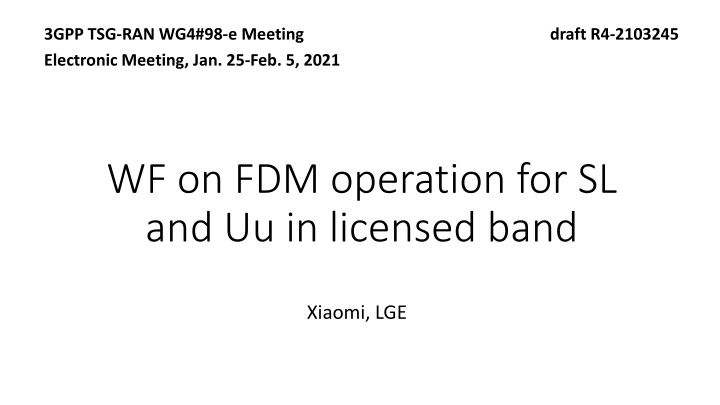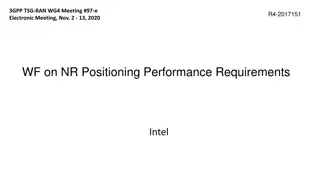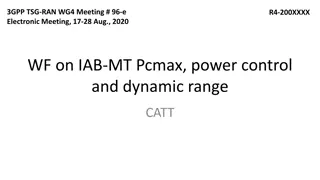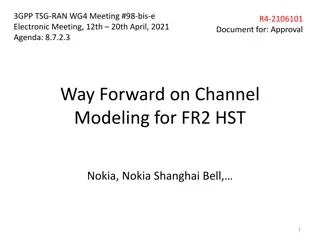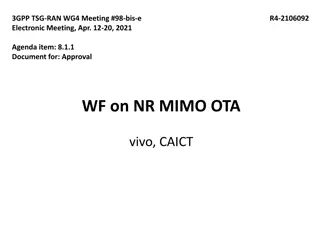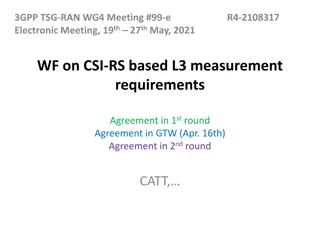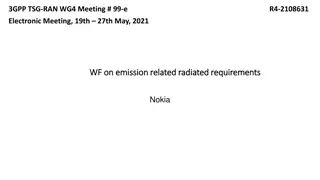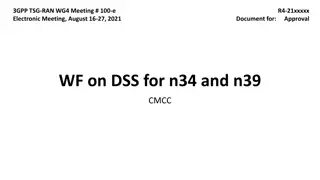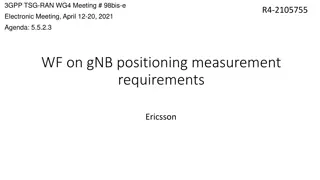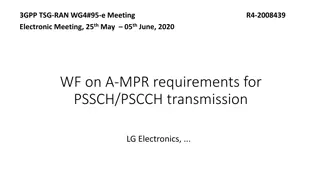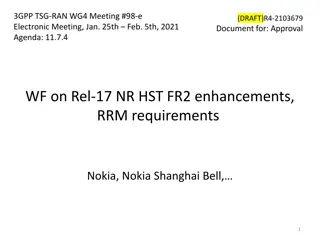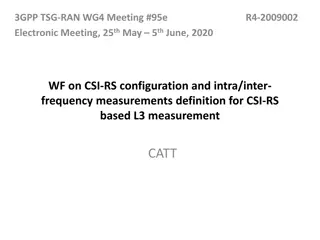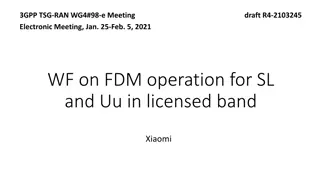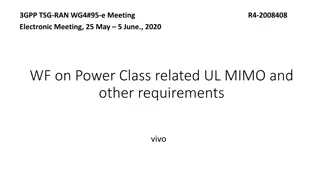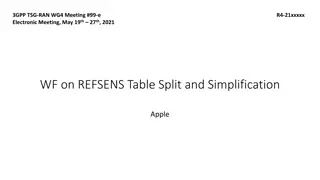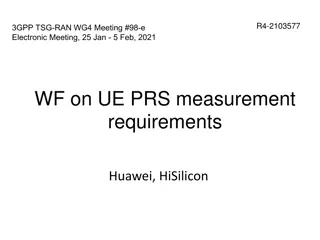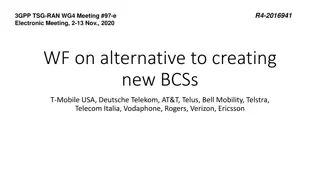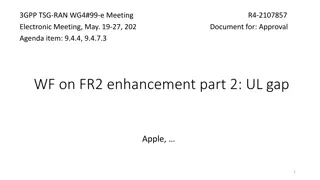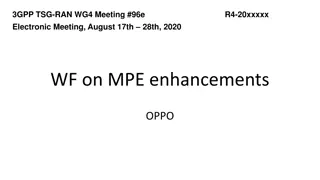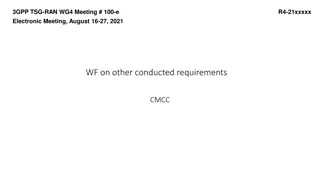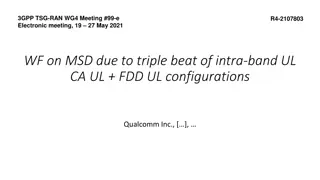Discussion on FDM Operation for SL and Uu in Licensed Band at 3GPP TSG-RAN WG4#98-e Meeting
The 3GPP TSG-RAN WG4#98-e meeting discussed introducing Frequency Division Multiplexing (FDM) operation for Uplink (UL) and Secondary Link (SL) in licensed bands. Topics included frequency separation, power control, RF architecture, and intra-band Carrier Aggregation (CA). Options were considered for shared or separate carriers for SL and Uu, with recommendations for both TDD and FDD bands. Additionally, the need for frequency separation studies in adjacent and non-adjacent channels was addressed. Concerns were raised about power issues impacting SL coverage due to FDM operation. Further investigation was recommended regarding power adjustments to prevent interference.
Download Presentation

Please find below an Image/Link to download the presentation.
The content on the website is provided AS IS for your information and personal use only. It may not be sold, licensed, or shared on other websites without obtaining consent from the author.If you encounter any issues during the download, it is possible that the publisher has removed the file from their server.
You are allowed to download the files provided on this website for personal or commercial use, subject to the condition that they are used lawfully. All files are the property of their respective owners.
The content on the website is provided AS IS for your information and personal use only. It may not be sold, licensed, or shared on other websites without obtaining consent from the author.
E N D
Presentation Transcript
3GPP TSG-RAN WG4#98-e Meeting draft R4-2103245 Electronic Meeting, Jan. 25-Feb. 5, 2021 WF on FDM operation for SL and Uu in licensed band Xiaomi, LGE
Background During the RAN4#98-e meeting, the following topic has been discussed for FDM operation of partial licensed band used for SL as: Whether to introduce FDM operation of UL and SL Frequency separation SL coverage with power control RF architecture Relationship with intra-band CA
Whether to introduce FDM operation of UL and SL 1, It has been agreed to introduce FDM operation of UL and SL. 2, FDM operation with shared or different carriers ? Option 1: RAN should allow FDM operation with one single or shared carrier for SL and Uu in licensed band Option 2: RAN should allow FDM operation with different carriers for SL and Uu in licensed band. Recommended WF Both option 1 and option 2 in TDD band can be considered. Both option 1 and option 2 in FDD band can be considered 3, FDM operation in TDD band or FDD band ? Option 1: TDD band Option 2: FDD band Recommended WF Both FDD on TDD band can be considered.
Frequency Separation in adjacent channel Candidate options: Option 1: RAN4 study frequency separation in case of FDM operation between SL and Uu Option 1a:RAN4 study frequency separation in FDM operation between SL and Uu to allow simultaneous UL Tx and SL Rx. Option 2: No frequency separation needs to be studied. Option 2a: RAN4 can allow FDM operation in TDD licensed band with restriction of SL Tx/Rx only allowed in UL configuration when NR Uu has not transmitted signalling. Recommended WF Further discuss whether frequency separation study is needed.
Frequency Separation in non-adjacent channel Candidate options: Option 1: RAN4 study frequency separation in case of FDM operation between SL and Uu Option 1a:RAN4 study frequency separation in FDM operation between SL and Uu to allow simultaneous UL Tx and SL Rx. Option 2: No frequency separation needs to be studied. Option 2a: RAN4 can allow FDM operation in TDD licensed band with restriction of SL Tx/Rx only allowed in UL configuration when NR Uu has not transmitted signalling. Recommended WF Further discuss whether frequency separation study is needed.
Power issue The following power issue has been raised for FDM operation Coverage of SL due to power control may be seriously impacted by FDM operation The power of the Uu TX and SL TX may have to be reduced to prevent cross- coupling. Recommended WF: To further investigate the above power issues for FDM operation. Other issues are not precluded.
RF Architecture Candidate Option Option 1: Separate RF architecture Option 2: Up to UE implementation Recommended WF Separate RF architecture is agreed as one of the RF architecture. Further discuss the feasibility of shared RF architecture for FDM operation. Further discuss the RF architecture in the next RAN4 meeting.
Relationship to intra-band CA Whether the RF architecture and core requirements of 2UL intra-band CA could apply to V2X intra-band con-current operation in band n79 Proposals Option 1: YES Option 2: NO Recommended WF Option 2. Both the RF architecture and core requirements need further study comparing to independently from intra-band CA.
Reference [1] R4-2102991, Email discussion summary for [98e][143] NRSL_enh_Part_2, Moderator (CATT), RAN4#98e [2] R4-2100415, Discussion on operating scenarios for partial used SL operation, CATT, RAN4#98e [3] R4-2101875, On operating scenarios for partially used SL operation, Xiaomi, RAN4#98e [4] R4-2102343, Operating scenarios for partially used SL operation, Ericsson, RAN4#98e [5] R4-2100283, Consideration on partial usage operation with PC5 and Uu in a licensed band, LG Electronics France, RAN4#98e
Annex In slide 4, adjacent channel means as following figure as example in both TDD & FDD bands. Two carrier are adjacent, one is operated for NR SL and the other is for NR Uu. TDD FDD In slide 5, non-adjacent channel means as following figure as example in both TDD & FDD bands. TDD FDD Need study to protect NR V2X reception from NR Uu transmission in both operating scenarios.
